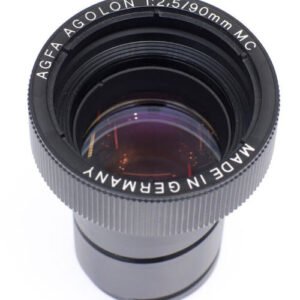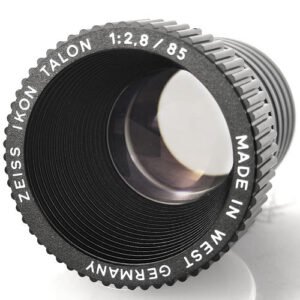| Weight | 182 g |
|---|---|
| Dimensions | 85 mm |
| Focal Length (mm) | |
| Max Aperture (f) | |
| Min Aperture (f) | |
| Aperture Blades | |
| Sharp (Near) | |
| Sharp (Far) | |
| RF/L Extension (mm) | |
| Flange-Focal Distance (mm @ ∞) | |
| Rear Mount | |
| Front Thread |
Wilhelm Will Zoom-Maginon 85-150/4
Slide projector zoom marked Will.Wetzlar. Black body. Zebra nose. Multicoated Lanthanum glass. Optional for Zeiss Perkeo range. Aperture unmarked (measured at f4.2-f4.5).
Category: Transparencies
Reviews
Add a review Cancel reply
Related to . . .
Related products
-

A. Schacht Travenon 85/2.8
Compare -

Agfa Color-Agolar 85/2.8
Compare -

Pentacon AV 150/2.8
Compare -

Agfa Agomar 150/2.8 [V2]
Compare -

Benoist Berthiot 75/2.8
Compare -

Agfa Color-Agolon 90/2.5
Compare -

Agfa Agomar 85-150/4
Compare -

Agfa Color-Agolar 250/4.5
Compare -

Braun Color-Autogon 85/2.8
Compare -

Agfa Agomar 90/2.4
Compare -

Agfa Agomar 60/2.8
Compare -

Aldis Anastigmat 85/2.5 [V1]
Compare -

Bell & Howell Trionar 100/3.5
Compare -

Agfa Agolon 90/2.5
Compare -

Agfa Agomar 85/2.8 [V4]
Compare -

Airequipt Luminac 100/3.5
Compare -

Aldis Projection 100/3.2
Compare -

Argus Projection 100/3.5
Compare -

Agfa Color-Agolar 60/2.8
Compare -
 SOFT
SOFTAgfa Agomar 90/2.8
CompareSOFT -

Agfa Agomar 70-120/2.8
Compare -

Pentacon AV 200/4
Compare -

Apollo 90/2.8
Compare -

AG Optical Trionar 152/3.5
Compare -

Arsenal Triar-3 85/2.8
Compare


















16:9 –
A peculiar hybrid of exotic and mundane, the 85-150 Zoom Maginon used rare earth glass and multicoating typical of good taking lenses, yet its trombone zoom mechanism is precisely as complicated as a pair of nested toilet-roll inners – even a slight tilt away from the horizontal causes this top-heavy lens to creep instantly. It’s a problem that you need to address with a DIY fix: anything that fractionally increases the diameter of the sliding front barrel suffices: ie, thin felt tape.
Sharpness is a mixed bag, too: At the short end, Zone 1 can be superb for a projector lens: reaching 8.3 at distance. However, resolution falls off as you zoom in (especially close up), where it falls into the low 7.0s. Apart from Silver-Level distant 85mm centre-frame performance – great for centrally-framed portraits, but little else – the Zoom Maginon doesn’t even reach a Bronzeworthiness for averaged framewide performance because of its very poor Zone 3 (full frame corners). On a smaller sensor, it won’t look as bad.
All that glass sliding around at one end makes it difficult to mount without a constraining tube to support its 175mm length. The Extension figure of 24-27mm we recorded for this lens (the focal-‘flange’ distance shifts by 3mm throughout the zoom range) is measured from the end of its original barrel. However, the rear elements sit 38mm inside and a permanent adaptation should remove as much excess barrel as possible. Apart from the improvement in handling, it solves mechanical vignetting issues at 150mm/infinity, unless you have 52mm+ helicals all the way to your camera mount adaptor.
Does the drawing style make adaptation worthwhile? The unmarked aperture turns out to be around f4.2 @85mm and f4.5 @150mm, so its ‘defocusing power’ isn’t as strong as fixed-focal alternatives. Bokeh is quite good: there’s still some PJ funkiness, but it’s not as characterful as some (no swirls, cat-eyes or strong soap-bubbles) or as smooth and well integrated as others. There’s some discreet outlining of hot specular highlights, but it remains predictable and capable of excellent results if you play to its strengths – the most notable of which are excellent flare-resistance and very good centre frame resolution at distance at 85mm.
Colour is a little muted, but contrast is very good – especially shooting into light. There is some blue/yellow CA, but it’s among the better-corrected zoom PJ optics, which as a group tend to suffer significantly in this regard. The other issue plaguing these lenses – varying geometric distortion – is present, too, following the standard pattern pattern of barrel>pincushion as focal length increases.
Overall, the Wilhelm Will Zoom Maginon has too many issues to recommend ahead of alternatives: notably the Rollei/Schneider 70-120 which is sharper, much better made, and has sweeter bokeh (though worse CA). More significantly, this isn’t an exception to the ancient maxim that zoom lenses make you pay for convenience in quality – an idea alien to those who have taken up photography since 2010. But back in the old days (when the Zoom-Maginon was made), it was the prevalent rule and this lens begs the question harder than most: why not just use a faster fixed focal?